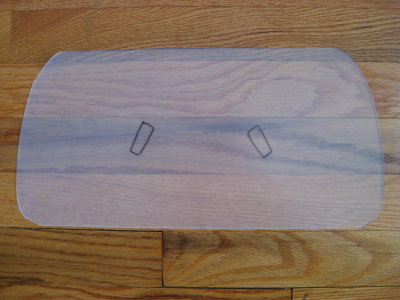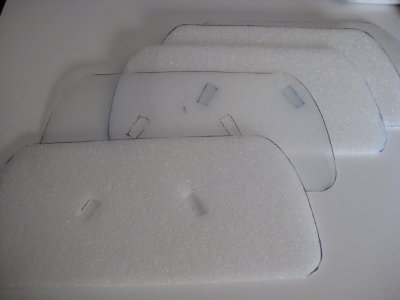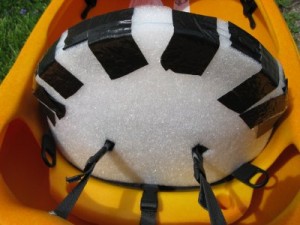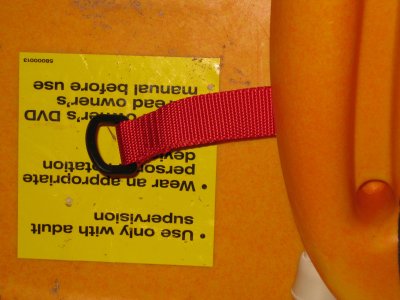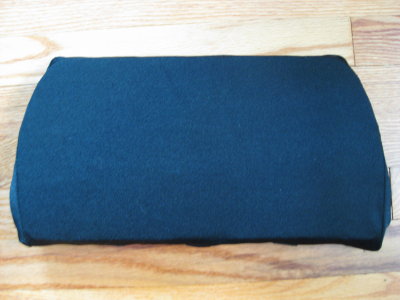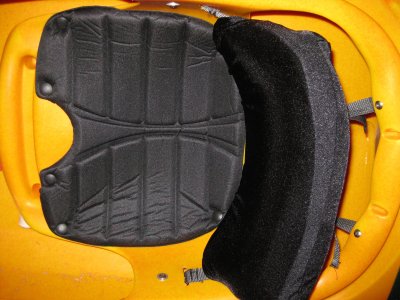On a maniacal Sunday a couple of weeks ago. I got up and made over my Vogue 8497 flop, made a kayak hanger, and designed a seat-back modification for my Tsunami SP kayak. It’s taken me until now to get this final post up after that particular marathon.
My kayak’s a Wilderness Tsunami SP. The “SP” in my kayak’s name stands for “smaller paddler”. It’s designed for bigger kids on up to small adults. I’m at the top of the size range, and the seat back just didn’t work quite right for me. I needed a little more height for better support, but there’s nothing available from the manufacturer to fix the problem.
I decided to see what I could do myself. I needed something light, but somewhat stiff, to give structure to my adaptation. I needed closed-cell foam to make the support comfortable. (Closed-cell foam is critical, because the last thing you want in a boat is foam that will soak up water.) I needed some way to attach the new support to the existing seat, and the whole thing would need a cover.
Here’s what I came up with.
Finding closed-cell foam was the real challenge. I stopped at a couple of boat dealerships, and asked about buying it, but was met with blank stares. At the second dealer, I spied this boat cushion:
The sales guy was dubious: He pointed out that these cushions are filled with thin sheets of foam, not solid blocks. I was thrilled; that’s exactly what I needed, so that I could pad out my seat an eighth of an inch at a time.
I found a huge, flexible-but-sturdy plastic cutting ‘board’ in the kitchen section of IKEA for the support piece. Armed with a black marker, heavy duty shears and a roll of duct tape, I began planning.
The back on my spouse’s seat is my preferred height, so I traced its outline on the IKEA board, and cut that out. Later on, I changed my mind, and cut the seat back lower: the greater height wasn’t perfect, and the higher back was going to be an issue when loading and storing the boat. The picture above is of that higher back, but it gives you an idea of how I began to fit the seat back to the kayak.
Here’s the template I ended up using, cut from the same IKEA board:
The angled rectangles are for the webbing straps that anchor the seat back; they got cut out later.
I ripped open the boat cushion, and, using the template, cut four sheets of foam. Three were for the front of the seat, and one for behind it.
I made a sandwich of these parts: back foam sheet, the IKEA board, then three foam sheets. I duct-taped the assembly together and fit it into the kayak seat. Webbing and buckles hold the seat back to the kayak, so I cut holes in the back foam sheet for those.
The foam holes are cut a little smaller than the rectangles in the rigid IKEA board — that’s so the the webbing will rub against foam, not the sharper edges of the IKEA template, which might wear the webbing over time.
Then I clipped my duct tape ‘muslin’ in place and sat in the kayak. (This photo’s actually for the higher back, but you get the idea.)
My back mod was nice and cushy, but it flopped (literally). There was too much ‘give’ in the existing seat back. My spouse and I finagled with it, and were finally able tighten the center buckle and strap so the the existing seat back no longer moved. This involved pulling the buckle under the seat itself, but the fit was “iffy”, and it had a tendency to slip.
Which led to another mod. I added a d-ring and a webbing extension to the buckle adjustment strap, and ran it to the front of the seat, so I could make adjustments while paddling, if I needed to, since there was no way for me to reach back and pull the existing strap while in the seat. To keep the strap from disappearing, I ran a piece of PVC piping across the underside of the seat, in front, and through the loop of the strap. You can see strap and the rubber stop I put on the end of the pipe in the picture below:
My new seat back needed a cover to maintain structural integrity. Using my foam sandwich as a template, I cut a front and back from black spandex, adding flaps at the bottom to close the cover, and appropriate seam allowances. Then I cut a strip of spandex the length of the curved sides of the sandwich, plus a seam allowance on each side.
I marked slots in the spandex for the straps, and interfaced the undersides. I used hook and loop tape to close the bottom of the cover, but I’ve heard that it loosens in water, so I also added two buckles to hold the cover on the foam back. Spandex isn’t strong enough to anchor the buckle straps, so I sewed a piece of webbing to the underside of the cover before assembling it, and then attached the buckle straps to the webbing on the outside of the cover.
Here’s how the cover looks closed. There’s a gap at the center bottom for the existing kayak seat anchor, and openings in the side of the cover for existing side adjusters that came with the kayak.
From the front, the seat back looks pretty sleek:
As it does in the kayak. Here’s the front:
And here’s how the back looks in place in the kayak:
This turned out to be a fabulous fix, and the seat now fits my body perfectly. Just like this amazing, fast and sleek kayak!





